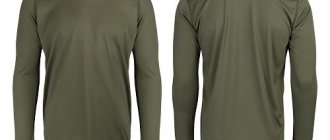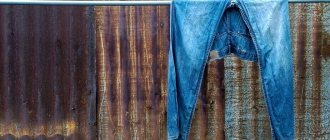Jeans have become a universal garment and a necessary part of the wardrobe for women, men and children. These durable, practical and stylish trousers come in a variety of colors and styles. For many, they are among their favorite and irreplaceable things.
But sometimes they suddenly turn out to be too big because you lost weight, or got the wrong size, or simply stretched out. Then you have to think about what to do so that the jeans fit true to size and do not stretch. Read about whether this can be achieved at home and how to do it in this article.
Compromise option: “shrinkage with return”
In order not to be too categorical and not to create unpleasant situations for their customers, many manufacturers have made a compromise and created something in between the described options. The resulting jeans are marked RAW SANFORIZED on the label, which means that the fabric has gone through the appropriate stages of sanforization, the essence of which is sequential soaking, steaming and stretching with load. Then the jeans are dried and in appearance are no different from the original material, but their shrinkage is minimal. It appears only immediately after washing, and after an hour of wearing the jeans return to their previous parameters.
Jeans processed in this way are the most popular segment among buyers, since the risk of buying the wrong size is reduced to zero.
Features of denim
Since 1853, workwear jeans have become a favorite and practical item for everyday wear. There is no concept of right and wrong. It all depends on the composition of the fabric. Denim fabric is made up of cotton, a type of pants with different composition and appearance. Main differences:
- Denim. They differ in density and light color from the inside.
- Jeans. A distinctive feature is the monotonous color and diagonal weaving of the threads.
- Stretch. Cotton fabric with elastic fiber that allows stretch clothing to stretch.
- Natural stretch. The same cotton fabric combined with Chinese nettle ramie fibers. The fabric is stretchy (elastic).
- Denim-silk. A distinctive feature is a glossy shine.
- Broken twill. It has a high density, relief, weaving in the form of a herringbone.
- Aykrew. The color of the fabric is pale or gray-yellow. This is cotton without dyeing.
Denim fabrics may differ from each other.
The quality depends on the origin of the cotton. In addition, they resort to the use of cellulose fabric - Tencel. It has advantages over viscose not only in appearance, production technology, and strength. It tends to influence the regulation of heat transfer.
Main types of cotton:
- Barbadian. Looks and feels soft and shiny.
- Mexican. Allows you to obtain smooth material without scars.
- Asiatic. The most common. It is highly affordable.
- Indian. Has the same characteristics as Asian cotton.
There are four main types of cotton.
Features include not only advantages and varieties, but also disadvantages. Alas, the disadvantages described below are not present in synthetics, but are inherent in natural fabrics. Cons: shrinkage, color loss (fading), slow drying process after washing.
For those who truly love raw denim
If the desire to buy trousers made from “real” denim cannot be suppressed by any “counterfeits”, then the shrinking procedure will need to be carried out on your own. To ensure that you have enough knowledge and the result is what is expected, you should use a few tips.
1. Required components:
– a large container in which jeans will fit “full-length” (you can use a bathtub, if you don’t mind);
– water heated to a temperature of at least 60 degrees Celsius;
- a weight that will prevent the jeans from floating to the surface (plastic bottles filled with water are perfect).
2. Jeans must be carefully placed at the bottom of the container so that there are no folds or creases on them, and pressed down with a weight. They should soak for at least 4 hours, and there is no need to panic if the water becomes colored. This is absolutely normal. Then the jeans are taken out and hung in such a way that water flows freely down them.
3. If after shrinking you cannot fit into your jeans (they have become tight in the waistband), then you can soak the waistband for another hour and then dry it using special spacers. They will give the width the required size.
Tips and tricks
To wear denim trousers comfortably, follow certain recommendations:
- After the first purchase of a product, it is advisable to wash it to refresh it and make the fabric more soft;
- Before washing the item, it is recommended to soak it for half an hour;
- Denim trousers are usually washed separately, with washing powder or washing gel previously diluted in water;
- When washing by hand, it is not advisable to rub contaminated areas vigorously - lighter stains may remain;
- Squeeze the jeans on a “delicate spin”, up to 800 rpm;
- It is advisable to iron the item slightly damp, from the wrong side. Then wearing it will become more comfortable, and the fabric will be soft;
- If the product is prone to shrinkage, it is advisable not to wring it out, but to let the water drain naturally and hang it to dry;
- The correct way to dry trousers is in a horizontal position or by hanging them upside down by the ends of the legs;
- It is not recommended to dry clean jeans - aggressive chemicals will quickly turn them into a piece of rag;
- If you wash the product by hand, first rinse it with warm water in the shower, and finally with cold water;
- To prevent the leather patch on the jeans belt from becoming deformed, it is lubricated with glycerin;
- It is not recommended to iron pants from the front side - there is a high probability that shine will appear;
- If you need the item to shrink, wash it at 60 degrees and hang it to dry in a warm place.
If your jeans have shrunk after washing, try simple and effective ways to get them back to their original shape. However, do not overdo it with stretching them - even a well-stretched fabric has a limit and can tear. Follow simple rules and the result will not be long in coming.
My jeans shrunk after washing, what should I do? There is an exit!
Perhaps today you cannot meet a single person who does not have jeans in his wardrobe. These trousers are practical, comfortable, go with any outfit and have not gone out of fashion for half a century. However, many people are concerned about the question: do jeans shrink after washing and what to do about this problem.
We can find the answer to the first question by referring to the product label:
- The “Shrink to fit” marking indicates that these jeans shrink greatly once, after the very first wash, and no longer change their shape. If you like these jeans in a store, it’s best to buy them a size larger in advance.
- If you purchased elastic jeans, the unpleasant situation with shrinkage simply will not arise. Rubber elastane threads woven into the fabric will not allow the product to lose its shape.
- classic jeans are usually made from denim, which, like most cotton fabrics, tends to deform after washing. In addition, the material is quite rough and hard, making it difficult to work with. Therefore, you will have to be as careful as possible with such products.
- Also, the features of further operation depend on whether the jeans are boiled or not. “Varenki” are extremely unpretentious and practically do not change their shape after washing.
But solving the second question requires some effort on your part.
How to determine in advance whether your pants will fit?
It is impossible to say 100% that pants will shrink after washing. However, the risks increase in the following cases:
- The fabric contains a large percentage of cotton. Products containing synthetic fibers are less likely to shrink.
- Suitable for washing at high temperatures.
- After washing, it is planned to subject the pants to an automatic spin cycle.
- Stretch jeans do not shrink. These things stretch great.
The more intensive processing the jeans undergo, the more likely they are to shrink. Read about the rules for washing jeans here.
How to wash jeans to make them stretch
So, you took jeans out of the washing machine that are a size or even two too small. The situation is unpleasant, but completely fixable. First of all, let's try to increase the size of the jeans by washing them correctly.
- It is best to use ordinary laundry soap rather than washing powder.
- If you decide to wash your jeans in a machine, watch the temperature: the water should not be hotter than 30°C.
- Don't wash your jeans for too long: half an hour should be enough for you.
- Dry items in fresh air or at room temperature. Hot air can cause additional deformation.
Cooking jeans
Instead of washing your pants, you can boil them, as women did in Soviet times. This procedure is guaranteed to reduce the size of the item, but will also affect its color. If you like blue-gray stains and a boiled-out tint, then feel free to proceed. If not, the method is not suitable for you.
- Take a large saucepan and fill it with water.
- What to weld jeans with? Add detergent: powder or regular soap. The solution should be saturated.
- Place the clothes in a saucepan, bring to a boil and simmer for about half an hour. Bonus: thanks to this washing, you can not only reduce the size of the product, but also get rid of old dirt.
We recommend: How to safely bleach a blouse at home if it has turned gray or yellowed?
Tip To avoid severe stains, turn the item inside out.
Stretch jeans that have shrunk after washing
If the method suggested above does not help, you will have to move on to more radical methods. Denim fabric is quite elastic and resistant to mechanical damage, so with some effort, you can stretch the product to the desired size.
- If shrunken jeans are made from natural materials with very little synthetic added, you can stretch them directly on the body. To do this, put on jeans, wet all problem areas (waistband, lower legs) and move actively. Please note that your movements must have a large amplitude and, at the same time, be quite smooth, otherwise you may tear the product. For best results, do not remove jeans until completely dry.
- You can also iron the product thoroughly and then put it on. A hot iron will soften the stiff fabric, making it easier to stretch.
- You don’t have to put on wet jeans, but simply stretch them with smooth movements, holding the waistband with both hands (if the product is tight at the waist) or the area around the knees and ankles (if the legs are too short). Don't forget to pull the seams too, otherwise the fabric may ripple. Many housewives pre-coat the seams with special means for stretching shoes.
- A steam generator can also help you combat shrinkage: hot steam will soften the fabric and make it more elastic.
- If the jeans you purchased are very tight and of high quality, you can try using a special waist expander. Freshly washed, damp jeans are buttoned, after which the device is installed in them. It needs to be adjusted to the desired width and only then dry the product. Please note that such an expander can simply tear low-quality jeans.
Removing heavy soiling
In a situation where jeans are heavily stained, you should remove the stain before washing them. Let's figure out what methods will help you do this most efficiently:
- If you need to remove a greasy stain, you need to apply a few drops of dishwashing gel to it. Such household chemicals eat away fat quite effectively. After ten to fifteen minutes, you will need to remove the remaining product with a wet cloth.
- Also, traces of vegetable oil on jeans can be treated with any adsorbent: starch, baking soda or talcum powder. To clean the fabric, you need to generously cover the oil stain with the chosen product and leave it for about half an hour. Then clean it with a clothes brush.
- If your jeans are stained after coming into contact with a freshly painted bench, gasoline will help remove the paint. Only for the procedure you will need a purified solvent. First, you will need to place a paper kitchen towel under the paint stain. Then, carefully wipe off the dirt with a cotton swab soaked in gasoline. To remove dye or corrector from the smallest pores of the fabric, it will need to be slightly stretched before processing.
- Pre-freezing them in the freezer will help remove gum from jeans. When exposed to low temperatures, traces of chewing gum will harden. After this, the chewing gum can be easily scraped off with a knife.
- Before you try to wash off machine oil or diesel fuel, you will need to first apply kerosene to the greasy stain. This should be done with a clean cloth. To dissolve motor oil or diesel stains as effectively as possible, you can apply a cotton swab soaked in solvent to the oily stain for fifteen to twenty minutes.
- Removing coffee from jeans is quite problematic. Therefore, before starting the hygiene procedure, it is necessary to apply table salt mixed with glycerin to the coffee stain. The same method can be used to treat tea stains.
- Strawberry stains must be covered with fine table salt, after five minutes, remove it, and soak the red mark in white wine. This method is perfect for removing strawberries and other colored berries.
- Before you remove ink from your jeans, you need to carefully stretch the stained area and rub it with a cotton pad soaked in rubbing alcohol.
- To effectively wash off the grass, as well as traces of dirt, you need to apply a mixture of water and ammonia in a ratio of five to one to the dirt for half an hour.
- Superglue responds well to solvents. To wash it, you can use acetone, purified gasoline or kerosene. To clean your jeans, you will need to treat the superglue stain with your chosen product ten to fifteen minutes before washing.
What to do if jeans stretch after washing
Very often housewives have to deal with the opposite situation: after numerous washes, their favorite jeans become stretched and shapeless. You can correct this situation in the following ways:
- In most cases, all jeans made from natural materials shrink a little after washing. For maximum effect, wash them in hot water. This method is not suitable for synthetics: the threads will be damaged and the entire product will be deformed.
- Washed jeans should be thoroughly wrung out and, without straightening, hung next to a heat source. Or dry them in the machine using the most intense drying setting.
- Situations often arise when only a certain area of the product needs to be shrinked. To do this, mix clean water and fabric softener in a 3:1 ratio. Pour the mixture into a spray bottle and thoroughly saturate the problem areas with the solution. Then dry the jeans in the machine at the highest temperature and speed.
- If none of the above methods help, you can sew the jeans. To do this, determine where exactly the excess fabric is formed; most likely, you will have to make additional stitches in the waistband area, along the crotch seam or in the hip area.
- Stretched stretch jeans will have to be thrown away: damaged elastane can no longer be restored.
Drying correctly
How quickly and in what shape jeans dry also affects their size. In standard care there is a rule prohibiting accelerated drying in a drum or on a radiator.
Let's go in reverse and use technology to make stretched pants smaller:
- Tumble drying is the best and fastest option for drying washed trousers. They decrease evenly.
- Iron. To quickly pull off your pants this way, place an absorbent fabric underneath them. Iron from the wrong side. At the same time, you can slightly stretch the legs along the length if you only need to compress the waistband and width.
- Hair dryer. Use equipment to dry local areas. Drying jeans completely with a hairdryer takes a very long time, the moisture evaporates unevenly.
- A battery, oven or sunlight will speed up drying.
Tip If you need to reduce jeans only in width, hang them wet on clothespins. This way they will stretch out in length.
Different drying methods
When shrinking denim pants, drying is very important. This is what helps you end up with a smaller version of your favorite wardrobe item.
There are several options for proper drying:
- vertical and horizontal (in the second case, it is worth placing natural fabric under the item so that it absorbs excess moisture);
- using an automatic dryer (jeans that need to be smaller should be dried at maximum);
- any heater.
In extreme cases, you can use a hairdryer to dry things. But this is a rather long process and clothes may dry unevenly.











